
El Niño is currently chugging along, and forecasters expect it to continue for the next several months, with a 62% chance of lasting through April–June 2024. Since we’re heading into the winter, when El Niño’s effect on Northern Hemisphere temperature and rain/snow is most distinct, today we’ll drive by some of El Niño’s wide-ranging impacts.
On rails
First stop—this El Niño has now met the threshold for a “strong” event! The August–October Oceanic Niño Index, which measures the three-month-average sea surface temperature in the east-central tropical Pacific (the so-called Niño-3.4 region), was 1.5 °C above the long-term average (long-term is currently 1991–2020). The Oceanic Niño Index is our primary metric for ENSO (El Niño/Southern Oscillation, the entire El Niño and La Niña system). The monthly Niño-3.4 Index was 1.7 °C above average.
“Strong” here is in quotation marks because we don’t have an official definition of ENSO strength. Our unofficial thresholds for the strength of an El Niño event are an Oceanic Niño Index of 0.5–0.9 °C for weak, 1.0–1.4 °C for moderate, and above 1.5 °C for strong. Over 2.0 °C is considered “very strong,” or “historically strong.” I’m going to drop the quotation marks going forward, because they slow us down, and we’re motoring here!
We started noting the potential for a strong El Niño way back in April 2023, before El Niño had even arrived (that happened in June). Currently, forecasters estimate a greater than 55% chance that El Niño will remain above that threshold for strong through January–March 2024. There’s about a 1-in-3 chance that the Oceanic Niño Index will reach 2.0 °C, which has happened four times before in our 73-year record: 1972-73, 1982–83, 1997–98, and 2015–16.
Why does the strength of an El Niño matter? I’ll get to that. First, though, let’s cruise through the reasoning behind the forecast.
I’m on a boat
During an El Niño event, both the tropical Pacific Ocean surface and the atmosphere exhibit characteristic changes. The ocean surface is warmer than average, as I discussed above. Without El Niño, the usual atmospheric pattern, the Walker circulation, consists of rising air and storms over the far western Pacific, west-to-east winds high up in the atmosphere, descending air over the cooler eastern Pacific, and the trade winds, east-to-west winds near the surface.
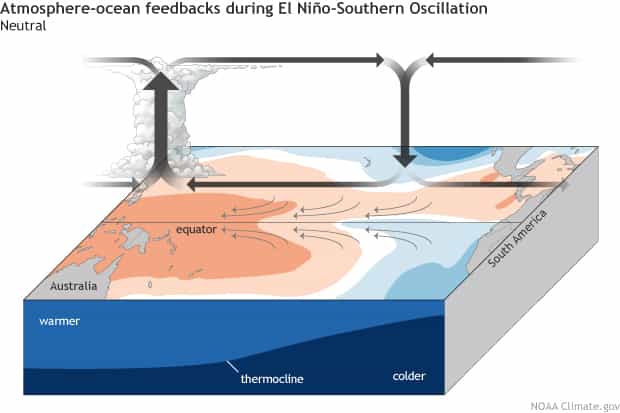
El Niño’s warmer-than-average central and eastern Pacific weaken this pattern, leading to less rain over the far western Pacific, more in the central, and sometimes eastern, Pacific, and weaker trade winds.
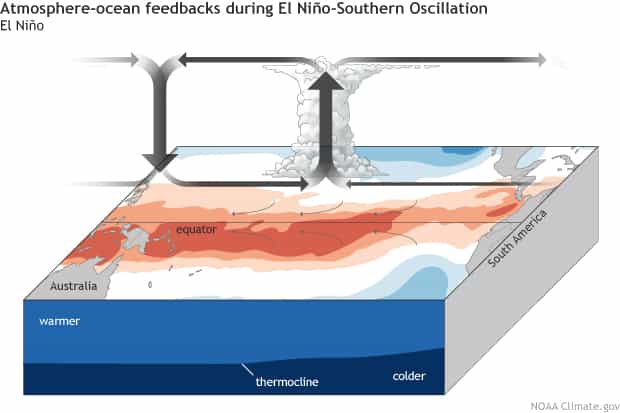
We’ve observed all of these characteristics of the weaker Walker circulation lately, indicating that El Niño’s engine is fully engaged.
The weaker trade winds help to continue and potentially strengthen the ocean surface temperature changes. Under average conditions, consistent trade winds drag across the surface and keep warm water piled up in the far western Pacific. When they weaken, warm water can start to slosh eastward under the surface, in a downwelling Kelvin wave. These waves can take a few months to travel across the Pacific, providing a source of warm water to continue powering the surface warming. Recently, we’ve seen evidence of increased warm water under the surface of the central tropical Pacific, and it appears another downwelling Kelvin wave is in progress.
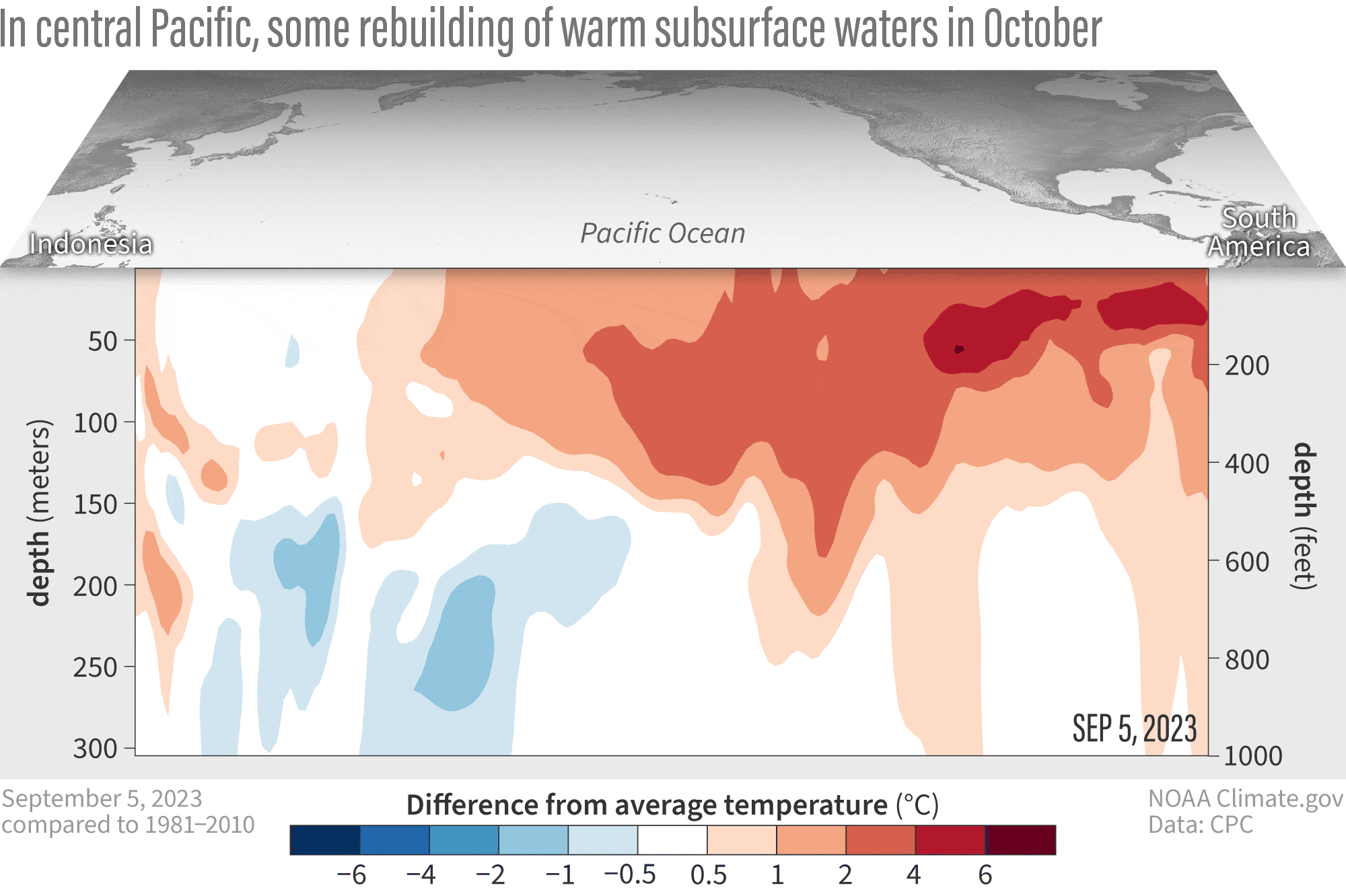
Similar to last month, the amount of warm water under the surface isn’t quite up to the October levels seen during the strong El Niño events in 1982, 1997, or 2015. For visuals, you can check out the scatter plot of September values from last month’s blog post, or look at the subsurface cross-sections from October 2023, 1982, 1997, and 2015. However, another downwelling Kelvin wave would increase the subsurface temperature anomalies in the eastern Pacific.
Airplane!
The strength of an El Niño event matters because the stronger the event, the more likely that we’ll see the characteristic changes in temperature, rain and snow, and other impacts. It doesn’t necessarily mean that the impacts themselves will be so much stronger, but it makes the expected El Niño impacts more likely to happen. Of course, where the weather is concerned, there are no guarantees! However, a stronger El Niño makes it a safer bet that we’ll see the expected patterns.
We’ve written a fair bit about El Niño impacts in our 9.5 years here at the ENSO Blog. Let’s buzz through a few:
- Just a couple weeks ago, Michelle covered El Niño + snow patterns.
- If you’re interested in how El Niño affects the jet stream, check out my recent post.
- How about El Niño and coastal flooding?
- When I was going nuts from writing about La Niña for three years in a row, I looked into how El Niño (and La Niña!) change the range of winter daily temperatures.
- Here’s a great guest post by Dr. Amy Butler about El Niño and the stratospheric polar vortex.
- Thinking about hopping a flight to Hawaii? Find out about ENSO and Hawaii, courtesy of Nat.
- Hawaii’s too warm for you? Here’s a guest post by Brian Brettschneider on ENSO and Alaska!
- This El Niño has a decent chance of hanging around through March–May, when it could play a role in reducing tornadoes and hail in the south and southeast U.S.
- Tom’s post on the complicated relationship between ENSO and the Indian monsoonis evergreen.
- Does El Niño increase atmospheric rivers? Nat and his colleague Kai-Chih Tseng investigate.
- El Niño impacts global health? Yep! Nat has the scoop.
- For the Australian perspective on El Niño, here’s a post by Andrew Watkins.
Dogsled
Our Alaskan friend-of-the-blog, Brian Brettschneider, was kind enough to provide us with maps that show how winter in North America turned out during past El Niños (there have been 29 since 1950) turned out (see footnote). For example, El Niño winters in Florida have more often been wetter (green) than average, while the Midwest has seen more drier-than-average (brown) El Niño winters.
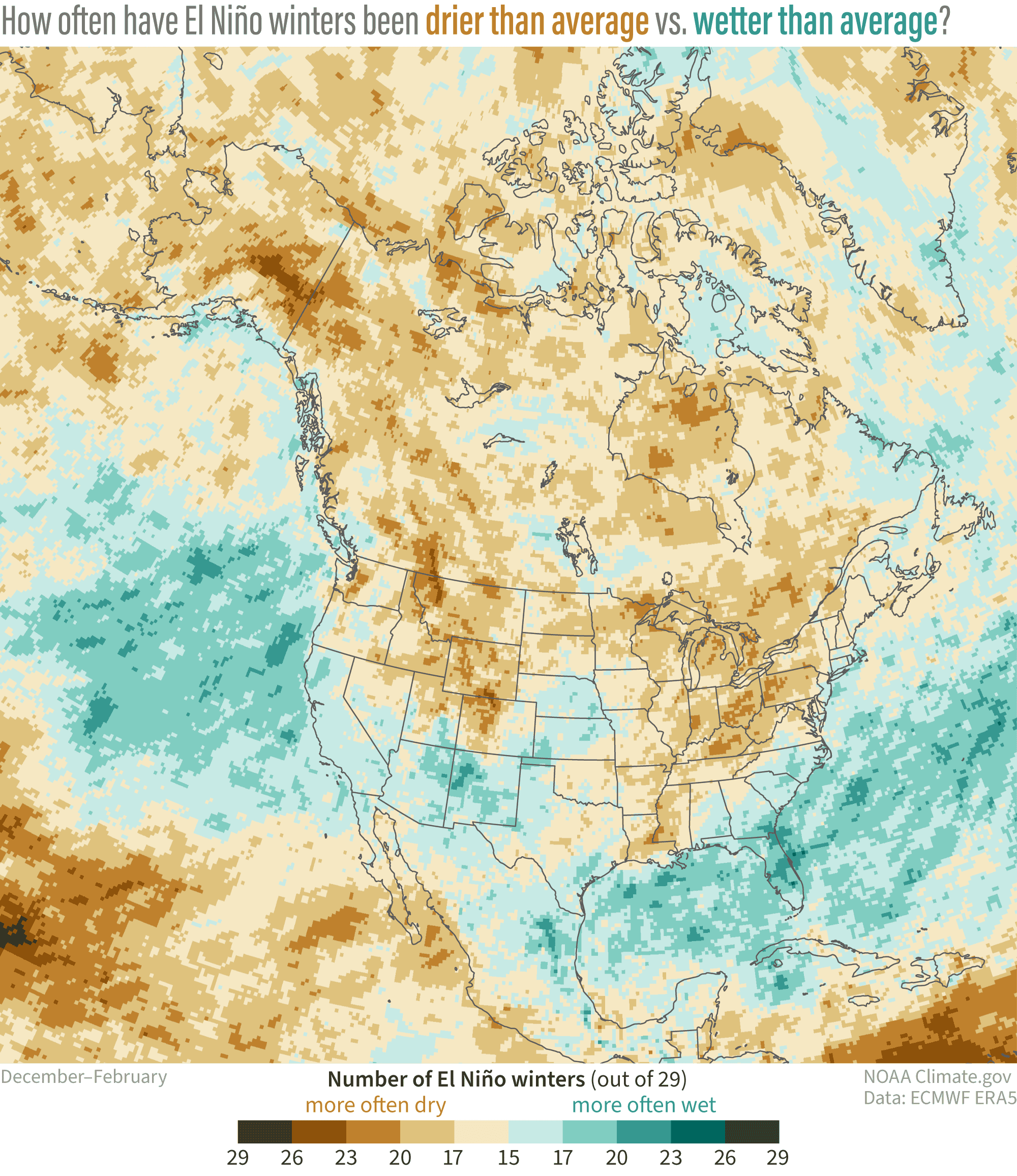
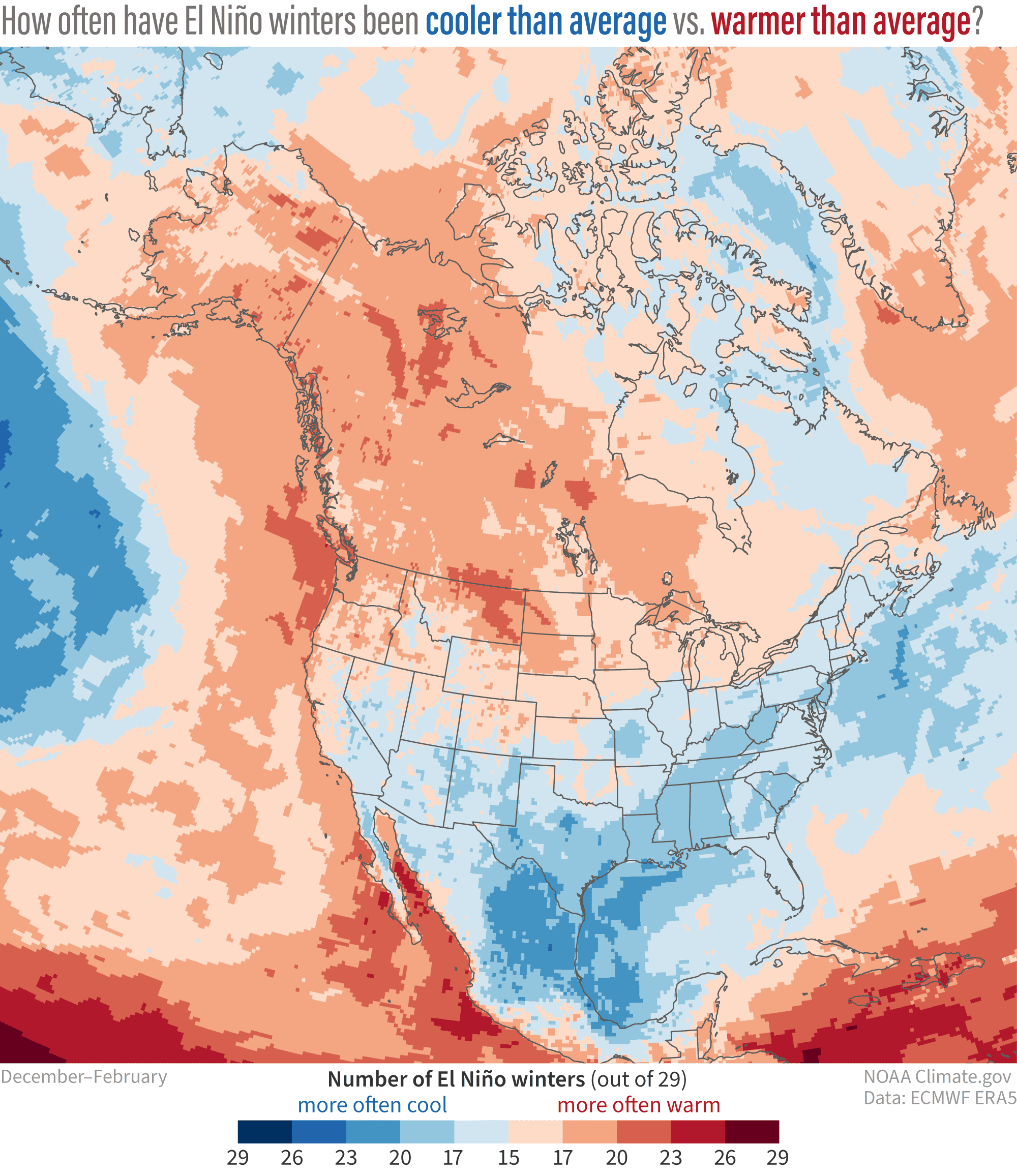
Northwestern North America has seen more warmer (red) than average El Niño winters, and the states around the Gulf of Mexico have been cooler (blue) more often. What do you see? Let us know in the comments!
That’s today’s trip through the wonderful world of ENSO. See you next month!
On foot(note)
Rebecca wrote a piece about the summer version of these maps. The maps are based on the “ERA5” reanalysis from the European Center on Medium-range Weather Forecasting, which covers the global climate from January 1940 to the present. A reanalysis is when scientists use a climate model to fill in gaps in past observations. Many observational records are incomplete due to stations moving, being discontinued, or missing data. Using a climate model, we can connect the dots between missing data and create a continuous record of the past climate. Reanalysis is an invaluable, widely used technique.
This post first appeared on the climate.gov ENSO Blog and was written by Emily Becker.